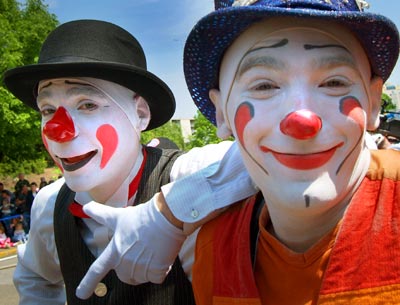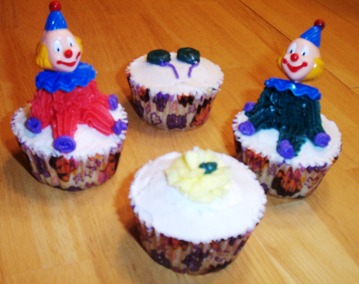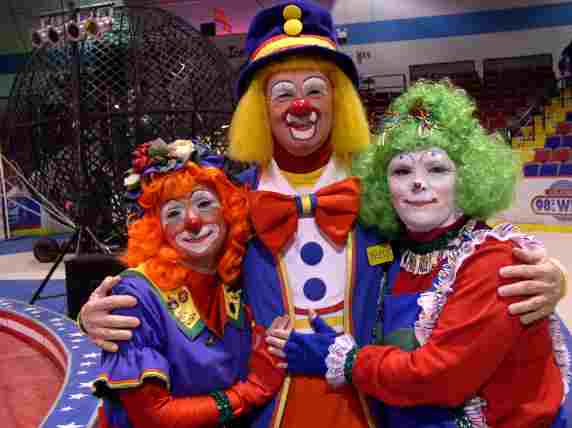And there was also the Shrine Circus founded in 1906 and affiliated with the Shriners' organization. It still travels to 120 cities annually. When I was about 5 years old Mother took me to see it at the sports arena of Illinois Wesleyan University. After the thrill of watching the motorcycles whirring around inside a steel globe, I was treated to an even bigger thrill. That incident involved an animal tamer who had allowed his Gorilla to purposely escape the cage and run into the bleachers. As he came toward me I was screaming and crying like a little girl. I nearly wet myself. He finally had to remove the head of his costume to reveal that he was just a man in gorilla suit. He seemed quite surprised to find it necessary to go to such lengths before I would stop my caterwauling (Caterwauling: To cry or screech like a cat in heat.)
Then the clowns came in. I was instantly transported to a place of happiness and make-believe. I enjoyed the clowns more than anything else. None could compare with Emmett Kelly and the "Weary Willie" character he had fashioned after depression era hobos. We could feel his sadness and yet he made us smile. His was the face of clowning.
Kelly had begun his career as a trapeze act with John Robinson's circus. It was there that he met and married Eva Moore who also performed as a trapeze artist. They went on to perform together as the "Ariel Kellys" and Emmett would occasionally perform as a white face clown. By 1931 he was clowning fulltime. I began clowning fulltime 30 years later in Mrs. O'Brien's 4th grade class. I spent most of that school year in the cloakroom.
Bozo is another famous clown that my generation grew up with. His bright red hair with that lacquered flip has become iconic as a symbol of Bozo. Created as a storytelling character for children for Capitol Records in 1946; he has continued to entertain children of all ages through Television and personal appearances. There were actually many actors who portrayed Bozo during the early T.V. years. The business model was of a franchise instead of a syndication which meant that local TV stations put on their own local productions of the show using their own Bozo. He remains one of America's favorite clowns.
Though the origin of the word is uncertain, it is thought to have come from the word "clod" which means a coarse or boorish person. Clowning's rich history can be traced to Greek burlesque and to the Roman stage. During the Middle Ages the Court Jester or Fool enjoyed a position of privilege with his master. As long as his antics amused the court he gained favor;, or he could sometimes be the object of the king's wrath. Cloaking his wit and wisdom in riddles, the "Fool" was often anything but.
Native Americans also have their own tradition of clowning. Their clowns played a religious role in the culture. They would participate in ceremonies used to ensure crop fertility for the tribe and good hunting. They taught the each new generation the importance of these ceremonies. Believing that it was necessary for the clowns to make everyone laugh to open their minds to learning; a clown was required to begin these rituals.
Asian clowns likewise serve a religious function and have roles in the telling of epic stories. Since the dialogue was in Sanskrit and the populace spoke Prakrit, it was necessary for Vidhusaka (the clown) to interpret for the audience.
The clown is a universal symbol that appears in all cultures throughout the ages. There is an innate quality in humans that finds an inexplicable fascination for clowns. Whether it is to be distracted monetarily from our own misfortune or because we see ourselves as the clown, we have a A desire within many of us calls to us to the art of clowning.
Do you yearn to be a clown? What child hasn't dreamed of running off with the circus and performing under the big top? The part of a clown would be the favored choice among many, I'm sure. Attending clown school is one way to learn the basics of applying make up, pie throwing and other slapstick buffoonery.
In 1968, Irvin Feld saw the need for formal clown training due to the declining and aging population of performers. Feld was the owner of the Ringling Brothers and Barnum & Bailey Circus. Together with Bill Ballantine (a longtime clown and frontman for Ringling) he established Clown College in Venice Florida; it was later relocated to Baraboo, Wisconsin which is also home to The International Clown Hall of Fame and Research Center (ICHOF).
Originally a 10 to 13 week course it was eventually scaled back to 8 weeks. Those weeks were filled with 9 hour days of students learning to "play off" one another to develop their basic clowning skills. The "Ringling style" which was taught at the school is rooted in the American type performance of slapstick. It is distinguished from the European type which is more stylized and elegant in its approach and often their appearance resembles a jester.
Candidates were selected through audition, and with 30 to 50 students accepted each year, it was an exclusive honor. Men outnumbered women about 7 to 1. The sessions continued as one long audition while instructors kept a watchful eye on pupils. The most talented had the potential opportunity to fill positions for the following season's shows.
The sessions were tuition free, but clown cadets had to cover their room and board. Students finished the term with full clown gear. Suit, shoes, wig and make up kit. A rubber chicken was optional.
By 1998 the school had relocated to Sarasota, Florida and there were more than 1500 graduates of the school. With clowns no longer on the endangered species list, Clown College closed its doors, having become a victim of its own success.
Still want to become a clown? There are a number of schools in operation throughout the world, including such far away places as Japan and Australia. Recruiting also remains active through Ringling Bros. Circus online at their Fun Zone site.
With peanuts, popcorn and cotton candy to satisfy the confectionery desires of kids and adults alike, an afternoon at the circus can be delightful and unforgettable. It makes summer as exciting as Christmas. I will remain thankful to the many circus performers who gave their all in providing me the thrills and chills of "The Greatest Show on Earth." And a very special thank you goes to the clowns.











